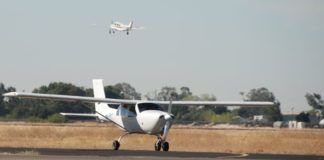It was time for us to leave Oshkosh last July, and the weather was marginal VFR. Departing VFR aircraft were blasting off Runway 9 with clockwork regularity under a 1200-foot ceiling with visibilities of 5 to 7 miles. Better weather waited up around Eau Claire, so we got in line. After takeoff, a few miles out, we were still legally VFR, but just barely. We were picking our way through clumps of low hanging stratus as the ceiling got lower along with our ground clearance. The visibility got worse as well. There I was, flying over unfamiliar Wisconsin countryside, lower and lower, to stay clear of clouds. The thought of hitting something-terrain, a tower, another low-flying VFR departure-was always there.
But I had help from Aspen Avionics AT300 in the instrument scan. This device, which is intended to replace the vertical speed indicator (VSI) in traditional panels (it fits into a 3.125-inch hole) provides critical terrain awareness, among other features. Using an external GPS for position and an internal database and barometric sensor, the AT300 allowed me to see exactly where the radio towers were and to know precisely what our distance above ground was.
Terrain Awareness Alternatives
The $2995 AT300 joins a growing crop of terrain-awareness solutions. For example, portable and panel-mount GPS navigators have terrain depiction already-in some cases for substantially less money than the AT300. (A Garmin GPSMAP 496, which is a fine navigator and has extra-cost XM weather available, is $600 cheaper.) Why in the world would anyone spend more for the AT300? The answer is that its for anyone who already has a traditional panel thats stuffed to the gills with steam gauges, a familiar GPS unit, and little hope of upgrading without a complete overhaul.
An Upgrade by Degree
The AT300 was designed as a drop-in replacement for the VSI, certified under TSO-C8d as a vertical velocity device, and TSO-C113 for an airborne multifunction display (MFD). (Interestingly, a VSI isn’t even required for Part 91 operations, VFR or IFR.) Using the data output string from legacy GPS systems, the AT300 provides color-coded terrain depiction, a GPS data display and of course the vertical speed information that used to be the only job of the old analog dial.
Putting it in the panel is as simple as replacing the old VSI with the AT300, and adding power and the data feed from the GPS. The electrical input and GPS information is done via a 15-pin D-sub connection, and the static system connection is the same one used for the original VSI. Best of all, the resulting installation is clean. No cables to tangle, no portable mounts to fuss with, and the display is right where you want it for quick readability.
Small Screen, Beaucoup Info
Making the most of screen real estate, the AT300 echoes only some of the GPS data along the top of the screen. This strip shows destination identifier and distance, heading to destination (and intercept direction), ground speed and time to destination. Three lower data windows show altimeter setting, magnetic heading and the selectable scale of the moving-map display.
The VSI function has been replaced by a vertical tape along the left edge of the screen, along with a small digital display window on the lower left corner that shows climb or descent in hundreds of feet per minute. Another window in the lower right corner shows current altitude AGL, and you can toggle off the upper strip of GPS data to show a profile view of projected flight path and obstructions.
The main appeal is the color-coded moving terrain and obstruction map that appears in front and to the sides of the airplane icon thats dead center on the bottom of the screen. Relying on the data stream from the GPS for the basic position, speed and distance calculations, the AT300 has its own terrain
and obstruction data card mounted on the side of the unit, which can be updated every six months. The terrain elevation is mapped in several different colors: Light green is 2500 to 1500 feet
below, dark green is 1500 to 500 feet below, yellow is 500 feet to the aircraft altitude. Red means the terrain is up to 1500 feet higher, and pink is more than 1500 feet higher than you are. Man-made obstacles such as radio towers are displayed in a similar fashion with a familiar tower icon.
Airports, both towered and uncontrolled, are shown with a little blue airport icon when the scale is set to less than 60 miles. However, airport identifications are omitted by design, as you can easily figure that out from your GPS unit. If there’s a flight plan stored in your GPS, a white course line and white diamond waypoints are also displayed, with the course segments changing to magenta when passed. This may sound like a lot to cram into a 240 x 480 pixel LCD, and it is. But Aspen has done a great job of keeping it all crisp and clear, with a sunlight readable, auto-dimming screen. The moving-map scale is quickly adjustable from 5 to 100 nautical miles, but it must be adjusted manually as there is no auto-scaling.
The AT300 uses a sophisticated set of logic algorithms based on descent rates and AGL altitudes to automatically determine its operating mode. When the aircraft is on the ground, departing or arriving at a nearby airport, a text tag appears in the center of the screen declaring such and all terrain is shown. When in the “en route” mode, all terrain more than 2500 feet below the aircraft is ignored and shows as black, depicting only the potentially significant terrain on the display.
Education through Operation
The AT300 is pretty bulletproof from an operational standpoint, but there are a few things that must be remembered. The most important one is that the terrain warning function is only as good as an accurate altimeter setting, which must be set by the crew. Its easy to do, but its also easy to overlook after you’ve routinely adjusted the numbers in the Kollsman window on the altimeter. Without an accurate setting to be used as a reference point, the terrain and obstruction depictions will be in error. Just for fun, I ran the AT300s altimeter setting up and down through its range during level flight. It was frightening how I could make all of the terrain go away entirely, or make it appear that we were on a collision course with the ground with just a simple twist of the knob.
Another thing to keep in mind is that the AT300 is susceptible to the same kind of mechanical errors found in traditional instruments during extreme cold. It shouldn’t be depended upon for the sole source of terrain clearance information under those conditions.
If you’ve always wanted to add color terrain warning to your panel, especially if you have an old GPS already, the AT300 just might be the ticket. It works with almost all legacy GPS units (except the original Northstar GPS), is easy to install, and could quite literally be a lifesaver.
For more information, call 505/856-5034 or visit the web at http://www.aspenavionics.com A direct link can be found at http://www.kitplanes.com




